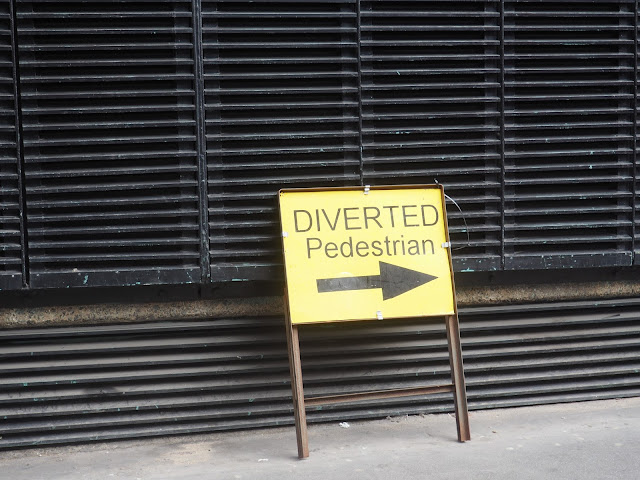Sometimes I discover walking stuff for
myself. Sometimes people send me things.
I discovered, more
or less under my own steam, that Wilkie Collins’ The Woman In White contains a
whole lot of walking (no doubt most of the world knew this already) - 197
usages of the word walk and its variants in the book, along with stroll, and
the occasional ramble, step, march and stride, and so on.
Here’s
some crucial early walking in the novel:
“I had now arrived
at that particular point of my walk where four roads met—the road to Hampstead,
along which I had returned, the road to Finchley, the road to West End, and the
road back to London. I had mechanically turned in this latter direction, and
was strolling along the lonely high-road … when, in one moment, every drop of
blood in my body was brought to a stop by the touch of a hand laid lightly and
suddenly on my shoulder from behind me.
“I turned on the
instant, with my fingers tightening round the handle of my stick.
“There,
in the middle of the broad bright high-road—there, as if it had that moment
sprung out of the earth or dropped from the heaven—stood the figure of a
solitary Woman, dressed from head to foot in white garments, her face bent in
grave inquiry on mine, her hand pointing to the dark cloud over London, as I
faced her …
“‘Is that the
road to London?’ she said.”
What I didn’t
know, till I read it in the New York Review of Books, is that Wilkie Collins
and Charles Dickens walked together at a certain time in their lives. They co-wrote what became The Lazy Tour of Two
Idle Apprentices, based on a walking tour they
did in the north of England.
“These two had sent their
personal baggage on by train: only retaining each a knapsack. Idle (that’s the
overdeterministic name of one of the apprentcies) now applied himself to
constantly regretting the train, to tracking it through the intricacies of
Bradshaw's Guide, and finding out where it is now - and where now - and where
now - and to asking what was the use of walking, when you could ride at such a
pace as that. Was it to see the country? If that was the object, look at it out
of the carriage windows. There was a great deal more of it to be seen there
than here. Besides, who wanted to see the country? Nobody. And again, whoever
did walk? Nobody. Fellows set off to walk, but they never did it. They came
back and said they did, but they didn't. Then why should he walk? He wouldn't
walk. He swore it by this milestone!”
Things cooled between the two men after Collins’ brother
Charley “walked down the aisle” with Dickens’ daughter Kate. It was not a marriage made in heaven,
apparently.
*
And then fellow
walking scribe Anthony Miller sent me a quotation from Robert Mcfarlane that
appears in the 2012 documentary titled Patience (After Sebald) directed by Grant
Gee,
Macfarlane says, "The
British tradition is of walking as recovery and the American tradition is of walking
as discovery. That striding forms into the oncoming air of the world, for the
Romantic tradition, the British Romantic tradition, is a way to strip away the
accretions of civilization, the hawking and hammering of time lived in cities
and returning yourself to some original state, I mean, that's Rousseau: It's
European as well as it's British.
“But the
American tradition, it's there in the road movie, it's there in the sense that
we travel to liberate ourselves, to discover new ways of being, to acquire
whole new methods of life that may themselves turn into habits but don't begin
as them."
I keep wondering
if this is even remotely true. First of
all I wonder if I understand what he means by “recovery.” Recovery in the sense of getting better
again? As a remedy for illness? Well maybe, but that seems to be no less
British than American – look no further than Cheryl Strayed.
Or does he mean
recovery in the sense of repossession or reclamation? In a literal or metaphoric sense? Surely only the latter. You can’t stake a physical claim on the
landscape of, say, East Anglia, but you can certainly, metaphorically “make (or
remake) it yours.”
As for American
walking being a means to discover “new ways of being;” well what’s so American
about that? Isn’t that what the
Wordworths and De Quincey and all the rest were trying to do?
Still, maybe we
shouldn’t hold MacFarlane to this opinion too firmly. We all say dubious things when a microphone’s
put in front of us.



























